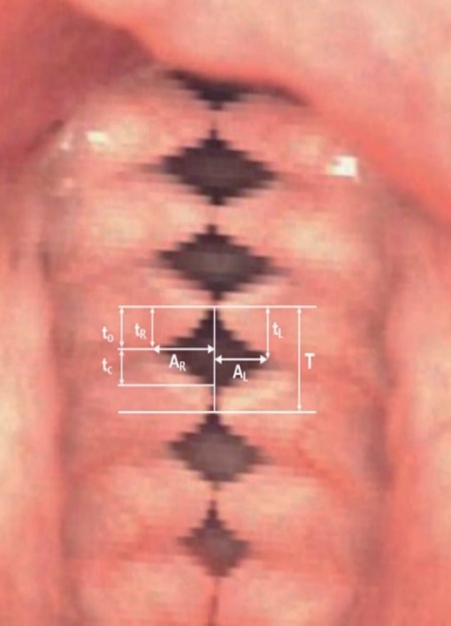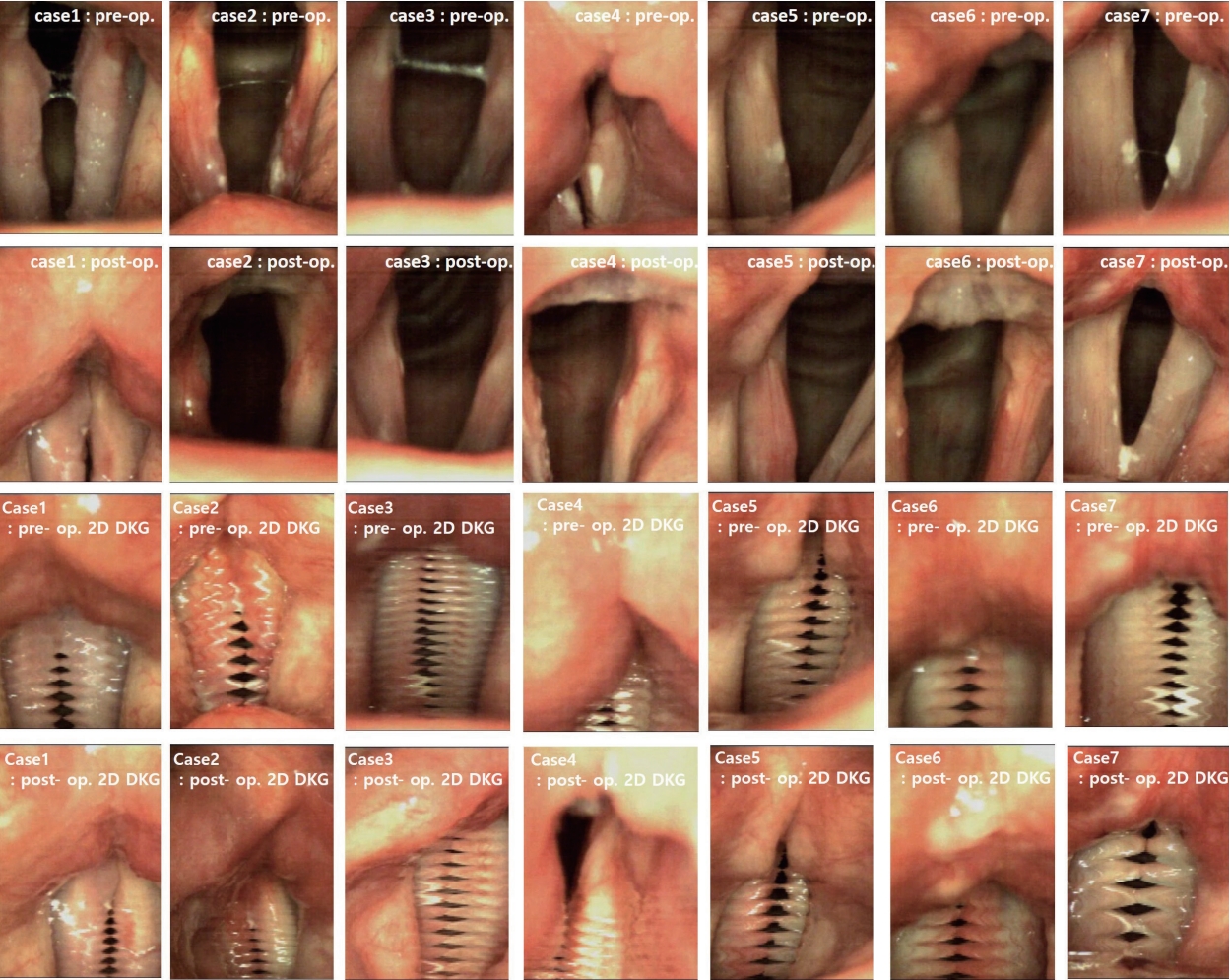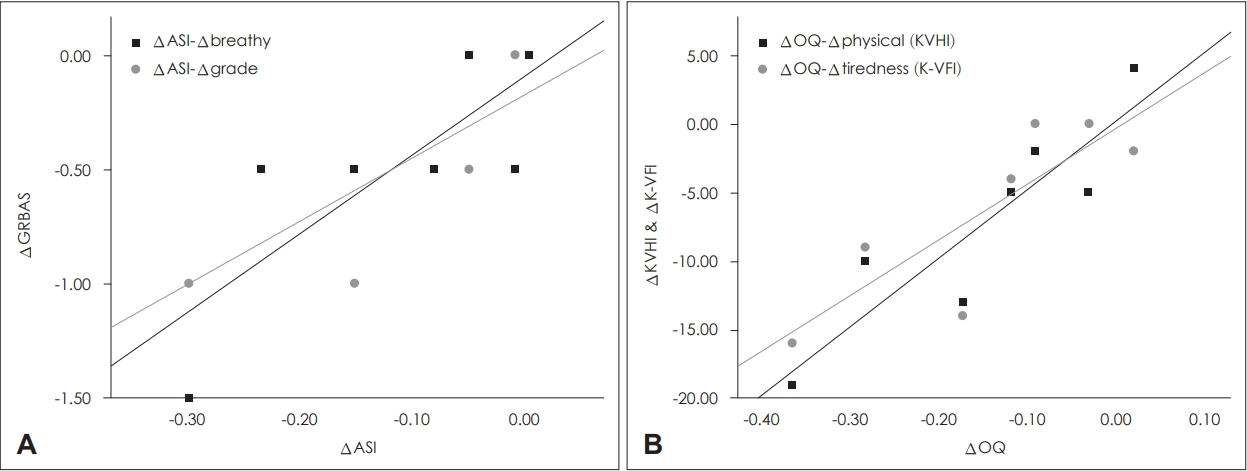 |
 |
AbstractBackground and Objectives Vocal fold leukoplakia is characterized as white plaque on the epithelium of the vocal folds and can be treated by angiolytic laser stripping surgery. However, postoperative changes in the vibratory patterns of vocal folds have not been investigated quantitatively. The purpose of this study was to investigate the changes in vocal fold vibration after angiolytic laser surgery in patients with unilateral vocal fold leukoplakia using the twodimensional scanning digital kymography (2D DKG).
Subjects and Method Medical records of seven males (age=62.14Вұ12.40 yrs) with unilateral vocal fold leukoplakia who underwent angiolytic laser stripping were reviewed. Before and after the surgery (post-operative day=82.57Вұ28.55 days), a multi-dimensional voice assessment was performed along with a 2D DKG study. For 2D DKG images, the amplitude symmetry index (ASI), phase symmetry index (PSI), and open quotient (OQ) were calculated using the ImageJ program. In addition, pre- versus postoperative data were compared, and the correlation between the changes in 2D DKG parameters and voice outcomes was explored.
ResultsResults indicated that the absolute ASI (p=0.028) and OQ (p=0.028) of the 2D DKG study, grade (p=0.038) and breathy (p=0.034) of the GRBAS scale, ПғPitch measured by the electroglottography (p=0.043), the physical score of the VHI (p=0.042), and the total score (p=0.043) and the tiredness score (p=0.043) of the VFI decreased after surgery. Decrease in the absolute ASI was correlated with changes in the grade (rho=0.850) and breathy (rho=0.777) scale measures, while decreased OQ were correlated with the changes in the physical score of the VHI (rho=0.901) and tiredness score of the VFI (rho=0.847).
Conclusion The improved vocal fold vibratory patterns after angiolytic laser surgery for vocal fold leukoplakia can be evaluated objectively using the 2D DKG study. Angiolytic laser stripping enables the preservation of vocal fold vibration after the surgery and is considered a valuable surgical option for treating vocal fold leukoplakia.
м„ң лЎм„ұлҢҖ л°ұл°ҳмҰқ(vocal fold leukoplakia)мқҖ л§Ҳм°°лЎң мүҪкІҢ м ңкұ°лҗҳм§Җ м•ҠлҠ” м„ұлҢҖ н‘ңн”јмқҳ м „м•”м„ұ л°ұмғү н”јл¶Җ лі‘ліҖмңјлЎң кіјк°Ғнҷ”мҰқ(hyperkeratosis), мқҙнҳ•м„ұмҰқ(dysplasia), нҺёнҸүмғҒн”јм„ёнҸ¬м•” л“ұмқҳ лӢӨм–‘н•ң лі‘лҰ¬ мҶҢкІ¬мқ„ ліҙмқёлӢӨ. 1960л…„лҸ„л¶Җн„° 2005л…„к№Ңм§Җ нӣ„л‘җ л°ұл°ҳмҰқмқ„ ліҙмқё нҷҳмһҗ 2188лӘ…мқ„ лҢҖмғҒмңјлЎң н•ң м—°кө¬м—җм„ң 50%лҠ” кіјк°Ғнҷ”мҰқкіј к°ҷмқҖ м–‘м„ұ лі‘ліҖмңјлЎң л°қнҳҖмЎҢмңјл©° лӮҳлЁём§Җ 50%лҠ” мқҙнҳ•м„ұмҰқмқ„ ліҙмқҙлҠ” м „м•”м„ұ, нҳ№мқҖ м•…м„ұ лі‘ліҖмңјлЎң л°қнҳҖмЎҢлӢӨ[1]. м „м•”м„ұ лі‘ліҖмқҳ 8.2%лҠ” м•…м„ұмңјлЎңмқҳ 진н–үмқ„ ліҙмқҙл©° мқҙнҳ•м„ұмҰқмқҳ м •лҸ„мҷҖ м•…м„ұмңјлЎңмқҳ ліҖнҷ”мңЁмқҙ мң мқҳлҜён•ң кҙҖкі„лҘј ліҙмқёлӢӨ. 비лЎқ м„ұлҢҖ л°ұл°ҳмҰқмқҙ м•…м„ұмңјлЎңмқҳ ліҖнҷ” к°ҖлҠҘм„ұмқ„ лӮҙмһ¬н•ҳмҳҖлҚ”лқјлҸ„ мғҒлҢҖм ҒмңјлЎң лҶ’мқҖ м–‘м„ұмқҳ к°ҖлҠҘм„ұкіј лӮ®мқҖ м•…м„ұ ліҖнҷ”мңЁмқ„ ліҙмқј лҝҗл§Ң м•„лӢҲлқј, кіјлҸ„н•ң м Ҳм ңлҠ” м„ұлҢҖм җл§үмқҳ мғҒмІҳлЎң мқён•ң мҳҒкө¬м Ғмқё мқҢм„ұмһҘм• лҘј мң л°ңн• мҲҳ мһҲкё° л•Ңл¬ём—җ мҲҳмҲ м Ғ м Ҳм ңлІ”мң„лҠ” мӢ мӨ‘н•ҳкІҢ кІ°м •н•ҳм—¬м•ј н•ңлӢӨ. мҲҳмҲ м Ғ м№ҳлЈҢлЎңлҠ” кі мӢқм Ғ м Ҳм ңмҲ нҳ№мқҖ CO2 л Ҳмқҙм Җ, нҳҲкҙҖмҡ©н•ҙ л Ҳмқҙм Җ(angiolytic laser) л“ұ лӢӨм–‘н•ң л Ҳмқҙм ҖлҘј мӮ¬мҡ©н•ң л°©лІ•мқҙ мһҲмңјл©°, мҲҳмҲ лІ”мң„м—җ л”°лқј мҶҢмһ‘мҲ (vaporization), кұ°мғҒмҲ (stripping), м Ҳм ңмҲ (resection) л“ұмқҳ мҲҳмҲ м Ғ л°©лІ•мқҙ мӮ¬мҡ©лҗҳкі мһҲлӢӨ. мқҙ мӨ‘ нҳҲкҙҖмҡ©н•ҙ л Ҳмқҙм ҖлҠ” нҳҲмғүмҶҢм—җ м„ нғқм ҒмңјлЎң нқЎмҲҳлҗҳлҠ” л Ҳмқҙм Җ кҙ‘м„ мқ„ мқҙмҡ©н•ҳм—¬ нҳҲм•Ўмқҙ н’Қл¶Җн•ң мЎ°м§Ғм—җ нҳҲкҙҖмҡ©н•ҙлҘј мқјмңјнӮҙмңјлЎңмҚЁ м •мғҒ мЎ°м§Ғм—җ лҢҖн•ң ліҙмЎҙкіј н•Ёк»ҳ м„ёл°Җн•Ёмқ„ мҡ”н•ҳлҠ” нӣ„л‘җлҜём„ёмҲҳмҲ м—җ м Ғн•©н•ң л Ҳмқҙм ҖлЎң лҢҖл‘җлҗҳкі мһҲлӢӨ.
м Җмһҗл“ӨмқҖ мөңк·ј мөңмҶҢм№ЁмҠөм Ғ м Ҳм ңл©ҙмқ„ нҷ•ліҙн• мҲҳ мһҲлҠ” л Ҳмқҙм Җ м Ҳм ңмҲ лҳҗлҠ” кұ°мғҒмҲ мқ„ мқҙмҡ©н•ҳм—¬ мқҢм„ұ ліҙмЎҙм—җм„ң мўӢмқҖ кІ°кіјлҘј ліҙкі н•ҳмҳҖлӢӨ[2]. м„ұлҢҖ л°ұл°ҳмҰқмңјлЎң CO2 л Ҳмқҙм ҖлҘј мқҙмҡ©н•ң нӣ„л‘җлҜём„ёмҲҳмҲ кіј нҳҲкҙҖмҡ©н•ҙ л Ҳмқҙм ҖлҘј мқҙмҡ©н•ң мҲҳмҲ мқ„ мӢңн–үл°ӣмқҖ нҷҳмһҗкө° к°„мқҳ м№ҳлЈҢ кІ°кіјлҘј 비көҗн•ҳмҳҖмқ„ л•Ң, л‘җ м№ҳлЈҢкө° к°„м—җ мһ¬л°ң нҳ№мқҖ м•…м„ұ ліҖнҷҳм—җ лҢҖн•ң м°ЁмқҙлҠ” ліҙмқҙм§Җ м•Ҡм•ҳмңјл©°, мқҢм„ұмқҳ ліҙмЎҙм—җ мһҲм–ҙм„ңлҠ” нҳҲкҙҖмҡ©н•ҙ л Ҳмқҙм ҖлҘј мқҙмҡ©н•ң нҷҳмһҗкө°мқҙ лҚ” мҡ°м„ён•Ёмқ„ ліҙмҳҖлӢӨ[2]. к·ёлҹ¬лӮҳ л Ҳмқҙм Җ мҲҳмҲ нӣ„ м„ұлҢҖ 진лҸҷ м–‘мғҒм—җ лҢҖн•ң м •лҹүм Ғ нҸүк°ҖлҠ” м•„м§Ғк№Ңм§Җ м—°кө¬лҗң л°” м—ҶлӢӨ.
м„ұлҢҖ 진лҸҷ нҠ№м„ұм—җ нҸүк°ҖмҷҖ м җл§үнҢҢлҸҷм—җ лҢҖн•ң м •лҹүм Ғ кі„мӮ° л°©лІ•мңјлЎң нӣ„л‘җ мҠӨнҠёлЎңліҙмҠӨмҪ”н”ј(laryngeal stroboscopy), кі мҶҚ нӣ„л‘җлӮҙмӢңкІҪ кІҖмӮ¬(high-speed videolaryngoscopy), м№ҙмқҙлӘЁк·ёлһҳн”ј(kymography) л“ұмқ„ мӮ¬мҡ©н• мҲҳ мһҲлӢӨ[3]. мқҙ мӨ‘ 2D л””м§Җн„ё м№ҙмқҙлӘЁк·ёлһҳн”ј(two-dimensional scanning digital kymography, 2D DKG)лҠ” л¶Ҳм•Ҳм •н•ң л°ңм„ұ мғҒнғңм—җм„ңлҸ„ мёЎм •мқҙ к°ҖлҠҘн•ҳл©° мёЎм •лҗң м„ұлҢҖ м җл§үмқҳ мӣҖм§Ғмһ„мқ„ мӢңк°Ғнҷ”н•ҳм—¬ н‘ңнҳ„н• мҲҳ мһҲлӢӨлҠ” м җм—җм„ң м„ұлҢҖ 진лҸҷ нҸүк°Җм—җ мһҘм җмқ„ к°Җм§Җл©°, мөңк·ј мһҗлҸҷнҷ”лҗң 분м„қмқ„ нҶөн•ң м •лҹүм Ғ мёЎм •лҸ„ к°ҖлҠҘн•ҙм§Җкі мһҲлӢӨ[4,5]. лҳҗн•ң кі мҶҚмҙ¬мҳҒлІ•мқ„ мқҙмҡ©н•ҳм—¬ м„ұлҢҖмқҳ лӘЁл“ мӣҖм§Ғмһ„мқ„ кҙҖмёЎн• мҲҳ мһҲлҠ” мң мқјн•ң л°©лІ•мңјлЎң м„ұлҢҖ л°ҳнқ”(vocal fold scarring) нҳ№мқҖ м„ұлҢҖ мң„축(vocal fold atrophy) л“ұм—җм„ң мң мҡ©м„ұмқҙ ліҙкі лҗң л°” мһҲлӢӨ[6,7]. м„ұлҢҖ л°ұл°ҳмҰқкіј к°ҷмқҙ л¶Ҳк·ңм№ҷн•ң м„ұлҢҖм җл§ү 진лҸҷнҢЁн„ҙмқ„ ліҙмқҙлҠ” м§Ҳнҷҳм—җм„ңмқҳ м„ұлҢҖ진лҸҷ нҢЁн„ҙ 분м„қм—җ к°•м җмқ„ к°Җм§Ҳ мҲҳ мһҲлӢӨ.
ліё м—°кө¬м—җм„ңлҠ” нҳҲкҙҖмҡ©н•ҙ л Ҳмқҙм Җ кұ°мғҒмҲ мқ„ мӢңн–үл°ӣмқҖ м„ұлҢҖ л°ұл°ҳмҰқмқҳ нҷҳмһҗл“Өм—җкІҢ 2D DKGлҘј мӮ¬мҡ©н•ҳм—¬ 진нҸӯлҢҖм№ӯм§ҖмҲҳ(amplitude symmetry index, ASI), мң„мғҒлҢҖм№ӯм§ҖмҲҳ(phase symmetry index, PSI), к°ңл°©м§ҖмҲҳ(open quotient, OQ)мқҳ м •лҹүм Ғ ліҖнҷ”лҘј мёЎм •, 비көҗ분м„қн•ҳм—¬ нҳҲкҙҖмҡ©н•ҙ л Ҳмқҙм ҖлҘј мӮ¬мҡ©н•ң м„ұлҢҖ л°ұл°ҳмҰқ кұ°мғҒмҲ мқҳ мҲҳмҲ нӣ„ м„ұлҢҖ진лҸҷ м–‘мғҒмқҳ нҳём „ м •лҸ„лҘј 비көҗн•ҳмҳҖлӢӨ. лҳҗн•ң 2D DKGм—җм„ңмқҳ мҶҢкІ¬кіј мқҢм„ұ нҳём „ м–‘мғҒмқҳ 비көҗлҘј нҶөн•ҙ м„ұлҢҖ 진лҸҷм—җ лҢҖн•ң м •лҹүм Ғ мёЎм • лҸ„кө¬лЎңм„ңмқҳ к°Җм№ҳлҘј нҸүк°Җн•ҙ ліҙм•ҳлӢӨ.
лҢҖмғҒ л°Ҹ л°©лІ•лҢҖ мғҒмқҢм„ұмһҘм• лҘј мЈјмҶҢлЎң ліёмӣҗм—җ лӮҙмӣҗн•ҳм—¬ мқҙ비мқёнӣ„кіј м „л¬ёмқҳм—җ мқҳн•ҙ м„ұлҢҖ л°ұл°ҳмҰқмңјлЎң 진лӢЁлҗң нҷҳмһҗ мӨ‘ м „мӢ л§Ҳм·Ён•ҳм—җ нҳҲкҙҖмҡ©н•ҙ л Ҳмқҙм Җ кұ°мғҒмҲ мқ„ мӢңн–үл°ӣм•ҳлҚҳ 7лӘ…мқҳ м„ұмқё лӮЁм„ұ(62.14Вұ12.40м„ё)мқ„ лҢҖмғҒмңјлЎң 진н–үн•ҳмҳҖлӢӨ. лӢӨлҘё нӣ„л‘җ м§Ҳнҷҳмқ„ лҸҷл°ҳн•ҳкұ°лӮҳ мқҙм „м—җ нӣ„л‘җ лҜём„ёмҲҳмҲ мқҙлӮҳ л°©мӮ¬м„ м№ҳлЈҢлҘј л°ӣмқҖ лі‘л Ҙмқҙ мһҲлҠ” нҷҳмһҗлҠ” м ңмҷён•ҳмҳҖлӢӨ. ліё м—°кө¬лҠ” нӣ„н–Ҙм Ғ м—°кө¬мқҳ нҳ•нғңлЎң 진н–үлҗҳм—Ҳмңјл©° кё°кҙҖм—°кө¬мңӨлҰ¬мӢ¬мқҳмң„мӣҗнҡҢ(Institutional Review Board No. 3-2020-0280)мқҳ мҠ№мқёмқ„ л°ӣм•ҳлӢӨ(Table 1).
мҲҳмҲ л°©лІ•мҲҳмҲ мқҖ м „мӢ л§Ҳм·Ён•ҳм—җ 진н–үлҗҳм—ҲлӢӨ. Dedo нӣ„л‘җкІҪмқ„ мқҙмҡ©н•ҳм—¬ 진м„ұлҢҖлҘј л…ём¶ңмӢңмј°мңјл©° мҲҳмҲ нҳ„лҜёкІҪмқ„ нҶөн•ҙ мӢңм•јнҷ•ліҙ нӣ„ 532 nm нҳҲкҙҖмҡ©н•ҙ л Ҳмқҙм Җ(QUANTA D562-6, Quanta System SpA, Samarate, Italy)мқҳ кҙ‘섬мң (laser fiber)лҘј м•…кө¬кІёмһҗ(alligator forceps)лҘј мқҙмҡ©н•ҳм—¬ лі‘ліҖмқ„ н–Ҙн•ҳлҸ„лЎқ н•ҳмҳҖлӢӨ. кҙ‘섬мң мқҳ лҒқл¶Җ분мқҙ лі‘ліҖмқҳ 3 mm мқҙлӮҙмқҳ лІ”мң„ м•Ҳм—җм„ң мқҙлҸҷн•ҳл©° мқјл°ҳм Ғмқё кІҪмҡ° лі‘ліҖ м „мІҙм—җ л Ҳмқҙм ҖлҘј л№„м ‘мҙүм„ұ лӘЁл“ң(noncontacting mode)лЎң 4 watt, 20 Hz мӮ¬мҡ©н–Ҳмңјл©° н•„мҡ” мӢң 5 wattмқҳ м„ёкё°лЎң м „лӢ¬н•ҳмҳҖлӢӨ. нҳҲкҙҖмҡ©н•ҙ л Ҳмқҙм ҖлҠ” мғҒн”ј л°‘мқҳ лҜём„ёнҳҲкҙҖмқ„ мҡ©н•ҙн•ҳм—¬ кі мң мёөмқҳ н‘ңл©ҙ(superficial lamina propria)кіј мғҒн”ј(epithelium)лҘј 분лҰ¬н•ҳмҳҖмңјл©° мқҙнӣ„ лӮҳнғҖлӮң лі‘ліҖмқҳ кё°м Җл§ү(basal membrane)кіј мғҒн”ј(epithelium) мӮ¬мқҙмқҳ лӢЁл©ҙмқ„ м•…кө¬кІёмһҗмҷҖ мҶңлӯүм№ҳ(cotton ball)лҘј мқҙмҡ©н•ҳм—¬ кұ°мғҒмӢңмјң лҜём„ён”јнҢҗмқҳ мқјкҙ„м Ҳм ңмҲ (en-bloc resection)мқ„ мӢңн–үн•ҳмҳҖлӢӨ. мқҙнӣ„ кІҖмІҙлҠ” лі‘лҰ¬кіјлЎң мҡҙл°ҳлҗҳм–ҙ лі‘лҰ¬н•ҷм Ғ 진лӢЁ кіјм •мқ„ кұ°міӨлӢӨ(Fig. 1).
2D л””м§Җн„ё м№ҙмқҙлӘЁк·ёлһҳн”ј 분м„қмҲҳмҲ нӣ„ 추м Ғ кҙҖм°°мқҖ 82.57Вұ28.55мқјк°„ 진н–үлҗҳм—Ҳмңјл©°, 5мқёмқҳ лҢҖмғҒмһҗ(мҰқлЎҖ 1, 2, 4, 5, 6)лҠ” мҲ нӣ„ 3к°ңмӣ”кІҪ, 2мқё(мҰқлЎҖ 3, 7)мқҖ мҲ нӣ„ 1к°ңмӣ”кІҪм—җ мӢңн–үн•ҳмҳҖлӢӨ. лӢӨкё°лҠҘнӣ„л‘җкІҖмӮ¬мӢңмҠӨн…ң(multidimensional examination system; USC-700MF; U-Medical, Busan, Korea)кіј 70В°кІҪм„ұ лӮҙмӢңкІҪ(8700 CKA; Karl Storz, Tuttlingen, Germany)мқ„ мӮ¬мҡ©н•ҳм—¬ м„ұлҢҖлҘј мҙ¬мҳҒн•ҳмҳҖлӢӨ. мҙ¬мҳҒн•ң мҳҒмғҒмқҖ м •лҹүм Ғ 분м„қмқ„ мң„н•ҙ 2н”Ҫм…Җ лқјмқё мҠӨмәҗлӢқмқ„ мӮ¬мҡ©н•ҳм—¬ 2D л””м§Җн„ё м№ҙмқҙлӘЁк·ёлһҳн”јлҘј кө¬нҳ„н•ҳмҳҖлӢӨ[5]. 2D л””м§Җн„ё м№ҙмқҙлӘЁк·ёлһҳн”ј 분м„қ мӢң мқҙлҜём§Җк°Җ ліҖнҳ•лҗҳлҠ” кІғмқ„ л°©м§Җн•ҳкё° мң„н•ҙ Adobe Illustrator (Adobe Systems Inc., San Jose, CA, USA) н”„лЎңк·ёлһЁм—җм„ң лІЎн„°нҷ”(vectorize)лҘј мӢӨмӢңн•ң нӣ„, ImageJ program (U. S. National Institutes of Health, Bethesda, MD, USA) 1.52aм—җм„ң 8 bit gray scaleлЎң ліҖнҷҳн•ҳм—¬ мҲҳмҲ м „нӣ„ ASI, PSI, OQлҘј мёЎм •н•ҳмҳҖлӢӨ(Fig. 2).
추к°Җм Ғмқё мқҢм„ұ 분м„қмқ„ мң„н•ҙ мҲҳмҲ м „нӣ„ лӘЁмқҢм—°мһҘл°ңм„ұм—җм„ң мқҢн–Ҙн•ҷм Ғ нҸүк°Җл°©лІ•мқё Analysis of Dysphonia Speech and Voice (ADSV) (Model 5109; KayPENTAX, Lincoln Park, NJ, USA)лҘј мқҙмҡ©н•ҳм—¬ мј‘мҠӨнҠёлҹј н”јнҒ¬ нҳ„м Җм„ұ(cepstral peak prominence, CPP), L/H мҠӨнҺҷнҠёлҹј 비мңЁ(L/H spectral ratio, SR), ПғCPP, ПғSRмқ„, Multi-Dimensional Voice Program (MDVP) (Model 5105, KayPENTAX)мқ„ мқҙмҡ©н•ҳм—¬ мЈјнҢҢмҲҳліҖлҸҷмңЁ(jitter percent), 진нҸӯліҖлҸҷмңЁ(shimmer percent), мҶҢмқҢ лҢҖ л°°мқҢ 비мңЁ(noise-to-harmonic ratio)мқ„ мёЎм •н•ҳмҳҖлӢӨ. м „кё°м„ұл¬ёнҢҢнҳ•кІҖмӮ¬(electroglottography, EGG)лЎңлҠ” realtime EGG analysis (Model 5138; KayPENTAX)лҘј мқҙмҡ©н•ҳм—¬ мҲҳмҲ м „нӣ„ л¬ёлӢЁмқҪкё°м—җм„ңмқҳ л°ңнҷ” кё°ліёмЈјнҢҢмҲҳ(speaking fundamental frequency, SFF), м„ұл¬ём ‘мҙүлҘ (contact quotient, CQ), ПғSFF, ПғCQлҘј мёЎм •н•ҳмҳҖлӢӨ.
лҳҗн•ң 7м җ мІҷлҸ„мқҳ GRBASлҘј мқҙмҡ©н•ҳм—¬ мҲҳмҲ м „нӣ„ лӘЁмқҢм—°мһҘ л°ңм„ұ л°Ҹ л¬ёлӢЁмқҪкё°м—җм„ңмқҳ мІӯм§Җк°Ғм Ғ нҸүк°ҖлҘј мӢӨмӢңн•ҳмҳҖмңјл©°[8], н•ңкөӯнҢҗ мқҢм„ұмһҘм• м§ҖмҲҳ(Korean version of Voice Handicap Index, KVHI)мҷҖ н•ңкөӯнҢҗ мқҢм„ұн”јлЎңм§ҖмҲҳ(Korean version of Vocal Fatigue Index, K-VFI) м„Өл¬ём§ҖлҘј нҶөн•ҙ мЈјкҙҖм Ғ мқҢм„ұнҸүк°ҖлҸ„ мӢӨмӢңн•ҳмҳҖлӢӨ[9,10].
нҶөкі„ 분м„қмҲҳмҲ м „нӣ„мқҳ мқҢм„ұ 비көҗлҠ” мңҢмҪ•мҠЁ л¶ҖнҳёмҲңмң„ кІҖм •(Wilcoxon signed rank test)мқ„ мӮ¬мҡ©н•ҳмҳҖлӢӨ. мҲҳмҲ м „нӣ„ 2D DKG мёЎм •ліҖмҲҳмқҳ ліҖнҷ”лҹүкіј мқҢм„ұліҖмҲҳмқҳ ліҖнҷ”лҹү к°„мқҳ мғҒкҙҖкҙҖкі„лҠ” мҠӨн”јм–ҙл§Ң мғҒкҙҖ분м„қ(Spearman correlation)мқ„ мӮ¬мҡ©н•ҳм—¬ м•Ңм•„ліҙм•ҳлӢӨ. мң мқҳ мҲҳмӨҖмқҖ 0.05лЎң м„Өм •н•ҳмҳҖлӢӨ.
кІ° кіј7лӘ… нҷҳмһҗмқҳ мЎ°м§Ғн•ҷм Ғ кІҖмӮ¬ кІ°кіј 6лӘ…мқҳ нҷҳмһҗк°Җ кіјк°Ғнҷ”мҰқ мҶҢкІ¬мқ„ ліҙмҳҖмңјл©° 1лӘ…мқҳ нҷҳмһҗк°Җ мқҙнҳ•м„ұмҰқ мҶҢкІ¬мқ„ ліҙмҳҖлӢӨ. 1лӘ…мқҳ нҷҳмһҗк°Җ м–‘мёЎм„ұмқҳ л°ұл°ҳмҰқмқ„, 6лӘ…мқҳ нҷҳмһҗк°Җ мқјмёЎм„ұ л°ұл°ҳмҰқмқ„ ліҙмҳҖмңјл©° к°Ғк°Ғ 3лӘ…м”© мҡ°мёЎкіј мўҢмёЎм—җм„ңмқҳ л°ұл°ҳмҰқмқ„ ліҙмҳҖлӢӨ. мҲ нӣ„ 추м Ғ кҙҖм°° мӨ‘ 1лӘ…мқҳ нҷҳмһҗк°Җ л°ұл°ҳмҰқмқҳ мһ¬л°ң мҶҢкІ¬мқ„ ліҙм—¬ нҳҲкҙҖмҡ©н•ҙ л Ҳмқҙм ҖлҘј мқҙмҡ©н•ң кұ°мғҒмҲ мқ„ мһ¬мӢңн–үн•ҳмҳҖлӢӨ.
нҷҳмһҗл“Өмқҳ мҲҳмҲ м „кіј нӣ„мқҳ кІҖмӮ¬л“Өм—җ лҢҖн•ҳм—¬ 분м„қн•ң кІ°кіј 2D DKGм—җм„ңмқҳ ASI (p=0.028), OQ (p=0.028)м—җм„ңмқҳ нҶөкі„м ҒмңјлЎң мң мқҳн•ң н–ҘмғҒ мҶҢкІ¬мқ„ ліҙмҳҖмңјл©°(Fig. 3) GRBAS мӨ‘ grade (p=0.038), breathy (p=0.034)м—җм„ң мң мқҳлҜён•ң к°җмҶҢлҘј ліҙмҳҖлӢӨ. ADSVмҷҖ MVDPмқҳ 분м„қ ліҖмҲҳл“Ө к°ҖмҡҙлҚ°м—җлҠ” мң мқҳн•ң м°ЁмқҙлҘј ліҙмқё ліҖмҲҳк°Җ м—Ҷм—ҲлҚҳ л°ҳл©ҙ, EGGмғҒм—җм„ңлҠ” ПғSFF (p=0.043)м—җм„ңмқҳ к°җмҶҢлҘј ліҙмҳҖкі , KVHIм—җм„ңлҠ” мӢ мІҙ м җмҲҳ(physical, p=0.042)к°Җ, K-VFIм—җм„ңлҠ” мҙқм җ(p=0.043)кіј н”јлЎңк°җ м җмҲҳ(tiredness, p=0.043)к°Җ мң мқҳлҜён•ң к°җмҶҢлҘј ліҙмҳҖлӢӨ. 2D DKGмқҳ мёЎм • ліҖмҲҳмҷҖ мқҢм„ұ мёЎм • ліҖмҲҳмқҳ ліҖнҷ”лҹү к°„ мғҒкҙҖкҙҖкі„лҘј мӮҙнҺҙліё кІ°кіј, к°җмҶҢлҗң ASIмқҳ ліҖнҷ”лҹү(О”ASI)мқҖ GRBASмқҳ О”grade (rho=0.850)мҷҖ О”breathy (rho=0.777)мҷҖ м–‘мқҳ мғҒкҙҖкҙҖкі„лҘј ліҙмҳҖмңјл©° к°җмҶҢлҗң О”OQлҠ” KVHIмқҳ О”physical (rho=0.901)кіј K-VFIмқҳ О”tiredness (rho=0.847)мҷҖ м–‘мқҳ мғҒкҙҖкҙҖкі„лҘј ліҙмҳҖлӢӨ(Fig. 4 and Table 2).
кі м°°м„ұлҢҖ л°ұл°ҳмҰқмқҖ лі‘лҰ¬н•ҷм Ғ 진лӢЁлӘ…мқҙ м•„лӢҢ мһ„мғҒмҶҢкІ¬м—җ лҢҖн•ң лӘ…м№ӯмңјлЎң, м „м•”м„ұ, м•…м„ұ к°ҖлҠҘм„ұмқ„ лӮҙнҸ¬н•ҳкі мһҲм–ҙ мҲҳмҲ мӢң мқҢм„ұ ліҙм „кіј н•Ёк»ҳ мў…м–‘н•ҷм Ғ кІҪкі„лҘј нҷ•ліҙн•ҳлҠ” кІғмқҙ мӨ‘мҡ”н•ҳлӢӨ. м№ҳлЈҢлЎңлҠ” cold instrumentлҘј мқҙмҡ©н•ң кі мӢқм Ғ мҲҳмҲ , CO2 л Ҳмқҙм ҖлҘј мқҙмҡ©н•ҳлҠ” лҜём„ём Ҳм ңмҲ , нҳҲкҙҖмҡ©н•ҙ л Ҳмқҙм ҖлҘј мқҙмҡ©н•ң кұ°мғҒмҲ л“ұмқҙ мӢңн–үлҗҳкі мһҲлӢӨ. CO2 л Ҳмқҙм ҖлҘј мқҙмҡ©н•ң мҲҳмҲ м Ғ л°©лІ•мқҖ м Ҳм ңмҲ мқҙ мҡ©мқҙн•ҳлӢӨлҠ” мһҘм җмқ„ к°Җм ё нҳ„мһ¬к№Ңм§Җ л§Һмқҙ мӢңн–үлҗҳкі мһҲмңјлӮҳ л Ҳмқҙм Җм—җ мқҳн•ң м—ҙмҶҗмғҒмңјлЎң мқён•ҙ м •мғҒ мЎ°м§Ғк№Ңм§Җмқҳ мҶҗмғҒмқ„ мң л°ңн•ҙ м„ұлҢҖ нҳ‘м°©(glottic stenosis), м„ұлҢҖ 섬мң нҷ”(vocal fold fibrosis), н”јм—ҙм—°кіЁ кі м •(arytenoid fixation)мқ„ мң л°ңн• мҲҳ мһҲмңјл©°[11], л°ҳліөм Ғмқё мҲҳмҲ мӢңм—җлҠ” мқҢм„ұмқҳ м§Ҳмқ„ лӮ®м¶ң мҲҳ мһҲлӢӨлҠ” м җмқҙ ліҙкі лҗҳм—ҲлӢӨ[12].
нҳҲкҙҖмҡ©н•ҙ л Ҳмқҙм ҖлҠ” л¶үмқҖ л№ӣмқҳ л¬јм§Ҳмқ„ м„ нғқм ҒмңјлЎң нқЎмҲҳн•ҳм—¬ нҳҲкҙҖмқҙ н’Қл¶Җн•ң мЎ°м§Ғм—җ кҙ‘м—ҙ분н•ҙлҘј мқјмңјнӮӨлҠ” л Ҳмқҙм Җл“Өмқ„ мқјм»«лҠ”лӢӨ. Potassium titanyl phosphate laser (KTP, 532 nm), pulsed dye laser (585-600 nm) л“ұмқҙ нӣ„л‘җмҲҳмҲ м—җ м Ғмҡ©лҗҳм—Ҳмңјл©°, мҡ°лҰ¬лӮҳлқјм—җлҠ” 532 nmмқҳ diode laserк°Җ мЈјлЎң мқҙмҡ©лҗҳкі мһҲлӢӨ. нҳҲкҙҖмҡ©н•ҙ л Ҳмқҙм ҖлҠ” мғҒн”јн•ҳ лҜём„ёнҳҲкҙҖ кө¬мЎ°(subepithelial microvasculature)м—җ кҙ‘м—ҙ분н•ҙлҘј мқјмңјмјң мғҒн”јмҷҖ кі мң мёөмқҳ н‘ңл©ҙмқҳ 분лҰ¬лҘј м•јкё°н•ҳм—¬ лҜём„ён”јнҢҗмҲҳмҲ (microflap surgery) н•ҳлҠ”лҚ° к°•м җмқ„ к°Җм§Җл©°, 섬мң нҷ”(fibrotic change)мқҳ мң„н—ҳм„ұмқҙ м Ғмңјл©° көҙкіЎ кҙ‘섬мң (flexible fiberoptics)лҘј мӮ¬мҡ©н•ҳм—¬ лӢӨм–‘н•ң мң„м№ҳм—җм„ңмқҳ мЎ°мӮ¬к°Җ к°ҖлҠҘн•ҳлӢӨ[13]. нҳҲкҙҖмҡ©н•ҙ л Ҳмқҙм ҖлҠ” нҠ№нһҲ нҳҲкҙҖм„ұ лі‘ліҖ(мһ¬л°ңм„ұнӣ„л‘җмң л‘җмў…, нҳҲкҙҖм„ұнҸҙлҰҪ л“ұ)кіј мһ¬л°ңм„ұ н‘ңмһ¬м„ұ м„ұлҢҖм җл§үм§Ҳнҷҳ(л°ұл°ҳмҰқ, м„ұлҢҖкө¬мҰқ л“ұ)м—җ мң мҡ©н•ң мҲ мӢқмңјлЎң ліҙкі лҗҳкі мһҲлӢӨ. м•„мҡёлҹ¬ лӢӨм–‘н•ң мҲ мӢқ ліҖнҳ•мқҙ к°ҖлҠҘн•ҳм—¬ мЎ°кё°м„ұл¬ём•”кіј к°ҷмқҖ м•…м„ұ лі‘ліҖм—җм„ңлҸ„ нҷңмҡ©мқҙ к°ҖлҠҘн•ҳлӮҳ л„“мқҖ лІ”мң„мқҳ лі‘ліҖмқ„ м ңкұ°н• мӢңм—җлҠ” мғҒлҢҖм ҒмңјлЎң мӢңк°„мқҙ лҚ” л§Һмқҙ мҶҢмҡ”лҗ мҲҳ мһҲлӢӨлҠ” лӢЁм җмқҙ мһҲлӢӨ[13]. ліё м—°кө¬лҠ” нҳҲкҙҖмҡ©н•ҙ л Ҳмқҙм ҖлҘј нҶөн•ң м„ұлҢҖ м җл§ү кұ°мғҒмҲ мқҙ мқҢм„ұ нҡҢліөм—җ мң мқҳлҜён•ң кІ°кіјлҘј ліҙм—¬мЈјм—Ҳмңјл©° мқҙлҘј нҶөн•ҙ м •мғҒ мЎ°м§Ғмқҳ мөңлҢҖ ліҙмЎҙкіј лі‘ліҖмқҳ мҷ„м „ м Ҳм ңлҘј к°ҖлҠҘн•ҳкІҢ н•ҳлҠ” м№ҳлЈҢлІ•м—җ лҢҖн•ҙ м ңмӢңн•ҳмҳҖлӢӨ.
м„ұлҢҖ 진лҸҷмқҳ нҸүк°ҖлҠ” мқҢм„ұмқҳ нҸүк°Җм—җ мһҲм–ҙм„ң н•„мҲҳм Ғмқё мҡ”мҶҢмқҙл©° мӮ¬мҡ©мқҳ нҺёлҰ¬н•Ёкіј кІҪм ңм„ұмңјлЎң мқён•ҙ 비디мҳӨ мҠӨнҠёлЎңліҙмҠӨмҪ”н”јк°Җ л§Һмқҙ мӮ¬мҡ©лҗҳкі мһҲлӢӨ. лӢӨл§Ң мҠӨнҠёлЎңліҙмҠӨмҪ”н”јлҠ” м„ұлҢҖмқҳ 진лҸҷмЈјкё°мҷҖ л§һм¶°м•јл§Ң м җл§үнҢҢлҸҷмқҳ мқҳлҜё мһҲлҠ” мҙ¬мҳҒмқ„ н• мҲҳ мһҲм–ҙ л¶Ҳк·ңм№ҷн•ң м„ұлҢҖмқҳ мӣҖм§Ғмһ„мқ„ ліҙмқҙлҠ” лі‘ліҖмқҳ мҙ¬мҳҒм—җлҠ” м Ғн•©н•ҳм§Җ м•ҠмқҖ л©ҙмқҙ мһҲлӢӨ. мқҙм—җ мҙҲлӢ№ 2000мһҘмқҳ мҙ¬мҳҒмқ„ н•ҳлҠ” кі мҶҚ нӣ„л‘җмҙ¬мҳҒлІ•мқҙ мӮ¬мҡ©лҗҳкё°лҸ„ н•ҳмҳҖмңјлӮҳ, мқҙлҠ” л§ҺмқҖ м–‘мқҳ м ҖмһҘкіөк°„мқ„ н•„мҡ”лЎң н•ҳл©° мҰүк°Ғм Ғмқё н”јл“ңл°ұмқҙ м–ҙл өлӢӨлҠ” лӢЁм җмқ„ к°Җм§Җкі мһҲм—ҲлӢӨ. 2D DKGлҠ” кі мҶҚнӣ„л‘җмҙ¬мҳҒлІ•мқ„ мӮ¬мҡ©н•ң лҚ°мқҙн„°лҘј н•ң мһҘмқҳ мқҙлҜём§ҖлЎң м •лҰ¬н•ҳм—¬ мһ‘мқҖ м ҖмһҘкіөк°„мқ„ м°Ём§Җн•ҳл©° мқҢм„ұмқҳ м •лҹүм Ғ нҸүк°ҖлҘј к°ҖлҠҘмјҖ н•ңлӢӨлҠ” м җм—җм„ң мғҲлЎңмҡҙ мқҢм„ұн•ҷм Ғ нҸүк°Җ л°©лІ•мңјлЎң лҢҖл‘җлҗҳкі мһҲлӢӨ. м„ұлҢҖ л°ұл°ҳмҰқмқҖ мһ„мғҒн•ҷм Ғ м •лҸ„м—җ л”°лқј м җл§үмқҳ мҡҙлҸҷм„ұмқҙ к°җмҶҢ нҳ№мқҖ мҶҢмӢӨлҗҳм–ҙ мһҲм–ҙ мЈјкҙҖм Ғмқё 분м„қм—җ кё°л°ҳмқ„ л‘җкі мһҲлҠ” кё°мЎҙмқҳ мҠӨнҠёлЎңліҙмҠӨмҪ”н”јл§ҢмңјлЎңлҠ” м •нҷ•н•ң мёЎм •мқҳ н•ңкі„лҘј к°–лҠ” кІҪмҡ°к°Җ мһҲм–ҙ нҳ‘лҢҖм—ӯ мҳҒмғҒ(narrow band imaging)мқҳ мӮ¬мҡ©мқ„ мҡ”н•ҳкё°лҸ„ н•ңлӢӨ[14]. 2D DKGлҠ” мқҙмҷҖлҠ” лӢ¬лҰ¬ кі мҶҚмҙ¬мҳҒмқ„ мқҙмҡ©н•ҳм—¬ м •нҷ•н•ң мӢңк°Ғнҷ”к°Җ к°ҖлҠҘн•ҳл©° к°қкҙҖм Ғмқё м§Җн‘ңлҘј нҷңмҡ©н•ҳм—¬ м„ұлҢҖмқҳ 진лҸҷм—җ лҢҖн•ң м •лҹүм Ғ нҸүк°ҖлҘј н• мҲҳ мһҲлӢӨлҠ” м җм—җм„ң м„ұлҢҖ л°ұл°ҳмҰқмқҳ 진лӢЁ л°Ҹ нҸүк°Җм—җ м°Ёлі„нҷ”лҗң мң мҡ©м„ұмқ„ м§ҖлӢҲкі мһҲлҠ” лҸ„кө¬лЎң мӮ¬мҡ©лҗ мҲҳ мһҲмқҢмқ„ ліё м—°кө¬лҠ” м ңмӢңн•ҳкі мһҲлӢӨ.
ліё м—°кө¬лҠ” 2D DKGк°Җ м„ұлҢҖ л°ұл°ҳмҰқмқҳ 진лӢЁм Ғ мң мҡ©м„ұмқ„ нҸүк°Җн•ҳкё° мң„н•ҙ ASI, PSI, OQлҘј мёЎм •н•ҳм—¬ мқҙлҘј 7м җ мІҷлҸ„мқҳ GRBAS, ADSVмқҳ мј‘мҠӨнҠёлҹј кҙҖл Ё ліҖмҲҳ, MDVPмқҳ мЈјкё°м„ұ кҙҖл Ё мқҢн–Ҙн•ҷм Ғ мёЎм •м№ҳ, EGG кҙҖл Ё ліҖмҲҳ, KVHIмҷҖ K-VFIмқҳ м„Өл¬ё м җмҲҳмҷҖ 비көҗн•ҳмҳҖмңјл©° мҲҳмҲ м „нӣ„мқҳ 2D DKGмқҳ мІҷлҸ„ л°Ҹ мқҢм„ұ мІҷлҸ„ 비көҗлҘј нҶөн•ҙм„ң м„ұлҢҖ кұ°мғҒмҲ мқҳ мң мҡ©м„ұмқ„ нҷ•мқён•ҳмҳҖлӢӨ. мҲҳмҲ м „нӣ„мқҳ 2D DKGмқҳ ASIмқҳ к°җмҶҢ л°Ҹ GRBAS мӨ‘ gradeмҷҖ breathinessмқҳ к°җмҶҢлҘј нҷ•мқён•ҳмҳҖмңјл©° ASIмҷҖ GRBASмқҳ gradeмҷҖ breathinessк°Җ м„ңлЎң мң мқҳлҜён•ң мғҒкҙҖкҙҖкі„лҘј ліҙмһ„мқ„ нҷ•мқён•ҳмҳҖлӢӨ. ліё м—°кө¬м—җм„ң нҳҲкҙҖ 분н•ҙм„ұ л Ҳмқҙм ҖлҘј мқҙмҡ©н•ң м„ұлҢҖм җл§ү кұ°мғҒмҲ мқҖ мқҢм„ұмқҳ ліҙмЎҙм—җ мһҲм–ҙ мң мқҳлҜён•ң кІ°кіјлҘј лӮҳнғҖлғҲмңјл©° нҷҳмһҗмқҳ мЈјкҙҖм Ғ мҰқмғҒкіј 2D DKGм—җм„ңмқҳ м •лҹүм Ғ мёЎм •мқҙ мң нҡЁн•Ёмқ„ нҷ•мқён• мҲҳ мһҲм–ҙ 2D DKGмқҳ 진лӢЁм Ғ лҸ„кө¬лЎңм„ңмқҳ мң мҡ©м„ұмқ„ мһ…мҰқн•ҳмҳҖлӢӨ. лҳҗн•ң KVHIм—җм„ңмқҳ мӢ мІҙм җмҲҳмҷҖ K-VFIм—җм„ңмқҳ н”јлЎңк°җ м җмҲҳмқҳ мҲҳмҲ м „нӣ„ 비көҗ мӢң к°җмҶҢн•ҳм—¬ нҳҲкҙҖмҡ©н•ҙ л Ҳмқҙм ҖлҘј нҶөн•ң м„ұлҢҖ кұ°мғҒмҲ мқҙ м„ұлҢҖ л°ұл°ҳмҰқм—җ лҢҖн•ң нҡЁкіјм Ғмқё мҲҳмҲ м Ғ м№ҳлЈҢмһ„мқ„ лӢӨмӢң н•ңлІҲ нҷ•мқён•ҙ ліј мҲҳ мһҲм—ҲлӢӨ.
ліё м—°кө¬лҘј нҶөн•ҙ м„ұлҢҖ л°ұл°ҳмҰқмқҳ мҲҳмҲ м Ғ м№ҳлЈҢл°©лІ•мңјлЎңм„ң нҳҲкҙҖмҡ©н•ҙ л Ҳмқҙм ҖлҘј мқҙмҡ©н•ң кұ°мғҒмҲ мқҙ мқҢм„ұ ліҙмЎҙм—җ мһҲм–ҙ нҡЁкіјм Ғмқё л°©лІ•мқҙл©° 2D DKGк°Җ 진лӢЁм Ғ л°©лІ•мңјлЎңмҚЁ мң нҡЁн•Ёмқ„ ліҙмҳҖлӢӨ. к·ёлҹ¬лӮҳ 7лӘ…мқҙлқјлҠ” мҶҢк·ңлӘЁ нҷҳмһҗмқҳ нӣ„н–Ҙм Ғ м—°кө¬мқҙл©°, к°Ғ лҢҖмғҒмһҗмқҳ мҲ нӣ„ кІҖмӮ¬ мӢңкё°мқҳ лІ”мң„к°Җ лӢӨмҶҢ л„“м—ҲлӢӨ. лҳҗн•ң мҲҳмҲ м Ғ л°©лІ•мқҳ лҢҖмЎ°кө°мқҙ мЎҙмһ¬н•ҳм§Җ м•Ҡм•„ мҲҳмҲ м Ғ л°©лІ•мқҳ к°ҖлҠҘм„ұмқ„ м ңмӢңн• мҲҳлҠ” мһҲмңјлӮҳ нғҖ мҲҳмҲ л°©лІ•кіјмқҳ 비көҗ мҡ°мң„лҘј нҷ•мқён• мҲҳ м—Ҷм—ҲлӢӨлҠ” м җм—җм„ң н•ңкі„к°Җ мһҲмңјлҜҖлЎң нӣ„мҶҚ м—°кө¬м—җм„ңлҠ” мқҙлҘј ліҙмҷ„н•ҳм—¬м•ј н•ңлӢӨ. л§Ҳм§Җл§үмңјлЎң 2D DKGлҠ” кё°мЎҙмқҳ мқҢм„ұкІҖмӮ¬ м§Җн‘ңл“Өкіј м—°кҙҖм„ұмқ„ мқјл¶Җм—җм„ңл§Ң лӮҳнғҖлӮҙкі мһҲм–ҙ, мқҢм„ұмқҳ к°ңм„ м •лҸ„м—җ лҢҖн•ң 추к°Җм Ғмқё кІҖмӮ¬л°©лІ• л°Ҹ м •лҹү м§Җн‘ңлҘј мқҙмҡ©н•ң ліҙлӢӨ лҢҖк·ңлӘЁмқҳ нӣ„мҶҚ м—°кө¬к°Җ н•„мҡ”н•ҳлӢӨкі нҢҗлӢЁлҗңлӢӨ.
ACKNOWLEDGMENTSThis work was supported by the Korea Medical Device Development Fund grant funded by the Korea government (the Ministry of Science and ICT, the Ministry of Trade, Industry and Energy, the Ministry of Health & Welfare, the Ministry of Food and Drug Safety) (Project Number: 1711174497, RS-2020-KD000093). This work was also supported by the National Research Foundation of Korea (NRF) grant funded by the Korea government (MSIT) (No. 2021R1G1A1094247).
NotesAuthor Contribution Conceptualization: Seung Jin Lee, Soo-Geun Wang, Jae-Yol Lim. Data curation: Jihoon Choi, Seung Jin Lee. Formal analysis: Seung Jin Lee, Hye Rim Chae. Funding acquisition: Seung Jin Lee. Investigation: Jihoon Choi, Seung Jin Lee, Hye Rim Chae, Min Seok Kang, Young Min Park. Methodology: Soo-Geun Wang. Project administration: Jae-Yol Lim. Supervision: Soo-Geun Wang, Jae-Yol Lim. Visualization: Seung Jin Lee, Hye Rim Chae. WritingвҖ”original draft: Jihoon Choi, Seung Jin Lee, Soo-Geun Wang, Jae-Yol Lim. WritingвҖ”review & editing: Jihoon Choi, Seung Jin Lee, Young Min Park, Soo-Geun Wang, Jae-Yol Lim. Fig.В 1.The surgical procedures of angiolytic laser stripping for vocal fold leukoplakia. A: Stroboscopic finding before surgery. B: The tip of the flexible laser fiber was grasped using alligator forceps and moved to its target within 3 mm of the lesion. C: After irradiating the entire lesion, the leukoplakic epithelium was separated and elevated from the vocal folds using a small cotton ball and grasping forceps. D: Surgical field after angiolytic laser stripping. 
Fig.В 2.Parameters of vocal fold vibratory characteristics using the 2D scanning digital kymography. Amplitude symmetry index=(AR-AL)/(AR+AL), phase symmetry index=(TR+TL)/T, open quotient=TO/T. Normophonic male (67 years old). 
Fig.В 3.Pre- and post-operative findings of the lesion sites and post-operative 2D DKG finding for each case are presented in the top, middle, and bottom line, respectively. 2D DKG, two-dimensional scanning digital kymography. 
Fig.В 4.Correlation between the changes in the 2D DKG parameters and voice outcomes after angiolytic laser stripping for unilateral vocal fold leukoplakia. ASI, amplitude symmetry index; KVHI, Korean version of Voice Handicap Index; K-VFI, Korean version of Vocal Fatigue Index; OQ, open quotient; 2D DKG, two-dimensional scanning digital kymography. 
TableВ 1.Demographic and clinical characteristics of the patient population (n=7) TableВ 2.Comparative analysis of pre- and post-operative variables
*pпјң 0.05. 2D DKG, 2D scanning digital kymography; ASI, amplitude symmetry index; PSI, phase symmetry index; OQ, open quotient; G, grade; R, roughness; B, breathiness; A, asthenia; S, strain; ADSV, Analysis of Dysphonia in Speech and Voice; CPP, cepstral peak prominence; SR, L/H Spectral Ratio; MDVP, Multi-Dimensional Voice Program; Jitt, Jitter percent; Shim, Shimmer percent; NHR, Noise-to-Harmonic Ratio; EGG, electroglottography; SFF, speaking fundamental frequency; CQ, contact quotient; VHI, Voice Handicap Index; VFI, Vocal Fatigue Index REFERENCES1. Isenberg JS, Crozier DL, Dailey SH. Institutional and comprehensive review of laryngeal leukoplakia. Ann Otol Rhinol Laryngol 2008;117(1):74-9.
2. Lim JY, Park YM, Kang M, Lee SJ, Baek K, Na J, et al. Angiolytic laser stripping versus CO2 laser microflap excision for vocal fold leukoplakia: Long-term disease control and voice outcomes. PLoS One 2018;13(12):e0209691.
3. Yamauchi A, Yokonishi H, Imagawa H, Sakakibara K, Nito T, Tayama N, et al. Quantification of vocal fold vibration in various laryngeal disorders using high-speed digital imaging. J Voice 2016;30(2):205-14.
4. Bae IH, Park HJ. Automated quantitative analysis of vocal fold vibration using two-dimensional scanning videokymography after transoral laser microsurgery. Clin Arch Commun Disord 2021;6(1):39-47.
5. Kang DH, Wang SG, Park HJ, Lee JC, Jeon GR, Choi IS, et al. Realtime simultaneous DKG and 2D DKG using high-speed digital camera. J Voice 2017;31(2):247.e1-7.
6. Bae IH, Wang SG, Lee JC, Sung ES, Kim ST, Lee YW, et al. Efficacy of two-dimensional scanning digital kymography in evaluation of atrophic vocal folds. J Voice 2019;33(4):554-60.
7. Kim GH, Lee YW, Bae IH, Park HJ, Wang SG, Kwon SB. Usefulness of two-dimensional digital kymography in patients with vocal fold scarring. J Voice 2019;33(6):906-14.
8. Choi SH, Yu M, Choi CH. Comparisons of 4-point GRBAS, 7-pointGRBAS, and CAPE-V for auditory perceptual evaluation of dysphonia. Audiol Speech Res 2021;17(2):206-19.
9. Kim JO, Lim SE, Park SY, Choi SH, Choi JN, Choi HS. Validity and reliability of Korean-version of voice handicap index and voicerelated quality of life. Speech Sciences 2007;14(3):111-25.
10. Kim MJ. Relationship between vocal fatigue index and voice handicap index for professional voice users [dissertation]. Seoul, Ewha Womans Univ.; 2017.
11. Siegel B, Smith LP. Management of complex glottic stenosis in children with recurrent respiratory papillomatosis. Int J Pediatr Otorhinolaryngol 2013;77(10):1729-33.
12. Holler T, Allegro J, Chadha NK, Hawkes M, Harrison RV, Forte V, et al. Voice outcomes following repeated surgical resection of laryngeal papillomata in children. Otolaryngol Head Neck Surg 2009;141(4):522-6.
|
|
|||||||||||||||||||||||||||||||||||||||||||||||||||||||||||||||||||||||||||||||||||||||||||||||||||||||||||||||||||||||||||||||||||||||||||||||||||||||||||||||||||||||||||||||||||

 |
 |